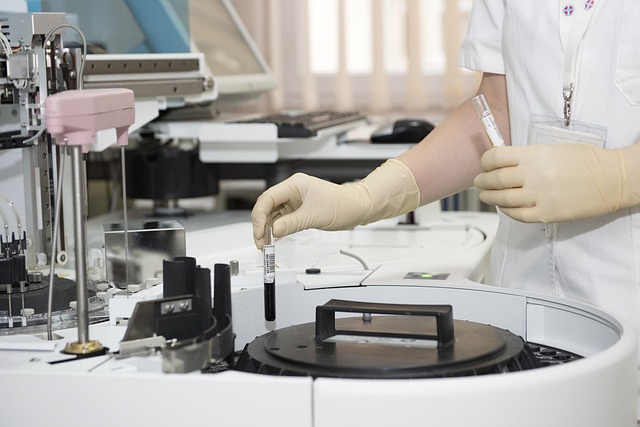In today's digital era, instant access to insights through advanced diagnostic tools is crucial for businesses and healthcare professionals. These tools, like point-of-care testing solutions and neurological assessment devices, provide quick, accurate data analysis, streamlining processes and improving efficiency. From emergency medicine to veterinary care, they empower decision-making, enhance patient outcomes, and reduce costs. When selecting select diagnostic tools, consider specific healthcare needs, ease of use, reliability, data security, and reputable brands. Tools like telemedicine platforms, genetic testing kits, and renal monitoring systems have revolutionized healthcare with remote monitoring, predictive insights, and personalized care. Implementing these tools requires strategic evaluation, user-friendly interfaces, robust data security, and regular updates for accurate results. Ultimately, select diagnostic tools enable real-time insights across sectors, enhancing productivity, efficiency, and public health decisions.
In today’s fast-paced business landscape, instant access to insights is no longer a luxury but a necessity. This article delves into the transformative power of rapid data analysis and interpretation, exploring how organizations can harness real-time intelligence for better decision-making. We discuss key factors in choosing the right select diagnostic tools, popular options for efficient insight generation, and practical strategies for implementation. Join us as we navigate successful case studies, highlighting the tangible benefits of instant access to insights.
- Understanding Instant Access to Insights: A Modern Necessity
- Benefits of Rapid Data Analysis and Interpretation
- Key Factors in Choosing the Right Diagnostic Tools
- Popular Diagnostic Tools for Efficient Insight Generation
- Implementing Instant Access: Strategies and Best Practices
- Case Studies: Successful Instant Access Implementation Stories
Understanding Instant Access to Insights: A Modern Necessity

In today’s fast-paced world, instant access to insights has become a modern necessity for businesses and professionals across various sectors. The ability to quickly gather, analyze, and interpret data enables informed decision-making and fosters innovation. This is especially crucial in fields like healthcare, where timely insights can significantly impact patient outcomes. For instance, oncology diagnostic aids offer rapid and accurate assessments, allowing medical experts to administer personalized treatments with enhanced efficacy.
Select diagnostic tools, such as point-of-care testing solutions and neurological assessment devices, play a pivotal role in providing instant access to valuable insights. These innovative technologies streamline processes, reduce wait times, and improve overall efficiency. By leveraging the power of advanced analytics and artificial intelligence, professionals can uncover hidden patterns, predict trends, and make data-driven choices that propel their organizations forward.
Benefits of Rapid Data Analysis and Interpretation

The ability to rapidly analyze and interpret data offers numerous advantages across various industries, and healthcare is no exception. With instant access to insights, medical professionals can make more informed decisions, leading to improved patient outcomes. This speed is particularly valuable in time-sensitive scenarios, such as emergency rooms or critical care units, where quick diagnostic tools like handheld diagnostic devices can be a game-changer. For instance, veterinary clinical assessment tools equipped with advanced analytics capabilities enable faster diagnosis of animal diseases, allowing for prompt treatment and better prognosis.
Moreover, rapid data analysis streamlines workflows, reduces costs, and enhances operational efficiency. Endocrinology diagnostic tools, for example, can provide real-time feedback on hormone levels, enabling early detection and management of endocrine disorders. This proactive approach to healthcare not only improves patient satisfaction but also reduces the burden on healthcare systems by minimizing hospital stays and preventing complications arising from delayed treatment.
Key Factors in Choosing the Right Diagnostic Tools

When selecting diagnostic tools for instant access to insights, several key factors come into play. First and foremost, consider the specific medical field or symptom checking area you’re targeting. Different applications and devices are designed for diverse healthcare needs—from general wellness tracking to specialized conditions. For instance, handheld diagnostic devices offer rapid results for common health markers like blood glucose or blood pressure, ideal for home-use diagnostic testers seeking immediate feedback.
Additionally, assess the ease of use and reliability of the tools. User-friendly interfaces and accurate, validated algorithms are crucial, especially with symptom checking applications, where incorrect interpretation can lead to misdiagnosis. Look for reputable brands that offer regular updates and maintain data security to ensure your insights remain confidential. Features like remote consultations and integration with healthcare professionals further enhance the value of these diagnostic tools.
Popular Diagnostic Tools for Efficient Insight Generation

In today’s digital age, the demand for instant access to insights has propelled the development of various diagnostic tools. Among these, telemedicine screening tools have emerged as a game-changer, enabling remote patient monitoring and efficient data collection. These platforms facilitate real-time communication between healthcare professionals and patients, significantly enhancing the speed and accuracy of initial assessments.
Additionally, genetic testing kits play a crucial role in insight generation by providing personalized health information based on an individual’s genetic makeup. This predictive approach empowers both patients and doctors to make informed decisions regarding preventive care and tailored treatment plans. Renal monitoring systems, another popular diagnostic tool, offer continuous surveillance for kidney function, early detection of abnormalities, and timely interventions, thereby improving patient outcomes and quality of life.
Implementing Instant Access: Strategies and Best Practices

Implementing instant access to insights requires a strategic approach, especially when selecting diagnostic tools that align with your goals. Start by evaluating your organization’s specific needs and the types of data you aim to capture. Different tools cater to various industries; for instance, healthcare professionals might rely on pulmonary function testers for respiratory health assessments, while environmental scientists could utilize advanced environmental health monitors to detect pollutants.
Best practices dictate a user-friendly interface, robust data security protocols, and seamless integration with existing systems. Consider the ease of data interpretation and visualization to ensure insights are accessible to all stakeholders. Additionally, regular updates and calibration checks are essential for accurate results, particularly with rapid antigen detection systems designed for quick yet reliable diagnoses.
Case Studies: Successful Instant Access Implementation Stories

In today’s fast-paced world, having instant access to insights can be a game-changer for businesses and organizations. Case studies demonstrate that successful implementation of diagnostic tools powered by miniature medical sensors and air quality testing devices has revolutionized various sectors. For instance, in endocrinology, advanced diagnostic tools enable healthcare professionals to monitor patients’ hormone levels in real-time, leading to more accurate diagnoses and personalized treatment plans.
These innovative solutions are not limited to healthcare; they’re also transforming industries like environmental monitoring. Air quality testing devices provide instant access to data on pollution levels, helping cities make informed decisions to improve public health. Similarly, businesses use these tools for quality control and process optimization, ensuring efficiency and productivity at every step. By selecting the right diagnostic tools, organizations can harness the power of real-time insights to stay ahead in their respective fields.
Instant access to insights is no longer a luxury but a necessity in today’s fast-paced business landscape. By leveraging the right diagnostic tools and implementing efficient strategies, organizations can unlock valuable data-driven insights that foster informed decision-making and competitive advantage. The key lies in selecting the most suitable tools based on specific needs, ensuring seamless integration into existing workflows, and embracing continuous improvement through regular evaluation and refinement. With the right approach, instant access to insights becomes a powerful enabler for organizational success and growth.
